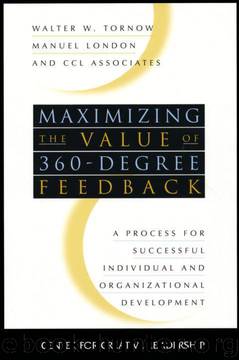Maximizing the Value of 360-degree Feedback: A Process for Successful Individual and Organizational Development (J-B CCL (Center for Creative Leadership)) by Walter W. Tornow;Manuel London

Author:Walter W. Tornow;Manuel London
Language: eng
Format: epub
Published: 2011-07-07T16:43:00+00:00
Feedback on Self as Learner
The content of traditional 360-degree feedback instruments focuses on end-state skills-otherwise known as managerial or executive competencies such as business knowledge, interpersonal skills, or commitment (Spreitzer and others, 1997). But individuals also need feedback on their learning competencies. For example, do they seek feedback? Do they take advantage of opportunities to do new things? Do they adapt to organizational transitions and change? Just as individuals are not always the best judge of their end-state competencies, they also need the perspective of others to understand their skills and abilities as learners.
There are two key reasons for providing feedback on learning competencies. First, end-state competencies, whether derived from research or experience, focus on what has made leaders and managers successful in the past. Future challenges will likely require managers to develop and adapt new skills beyond those that made them successful in the past. Because those new skills are to be used in the future and are not yet clearly defined, the only competency we can assess clearly now is the ability to learn. Our assumption is that people with the ability to learn will be more likely to develop the skills that are called for in the future.
Second, by understanding and improving their learning competencies, individuals' belief in their ability to do something about their weaknesses, and thus their sense of control, is enhanced. With traditional 360-degree feedback instruments, which focus on end-state skills, individuals become aware of the gap between where they are and where they need to be, relative to the set of competencies measured by the instrument. Although it is undeniable that knowing about a performance gap enables a person to begin the process of correcting it, it is unfair to hold individuals accountable for changes they do not yet have the skills to make happen. In other words, is the individual equipped with an understanding of his or her ability to close the gap? Imagine the frustration of having an awareness of a skill or performance deficit if, at the time of this heightened awareness, it is unclear what actions are needed or can be taken to fix it. Using instruments that facilitate learning about the way you learn can provide the critical element needed to develop personal strategies for closing the gap. Through insight and techniques for closing the gap, individuals will also experience an enhanced sense of belief in their ability to develop in the areas that are demanded of them, whatever they may be. The resultant sense that they are in control of their perceived deficit contributes greatly to the motivation to work on their development. Further, research has shown that enhancing the level of belief in one's ability increases the likelihood of goal attainment, which is a key measure of developmental progress over time.
Two examples of 360-degree feedback instruments that provide feedback on self as learner are Prospector and Learning Agility: The Learning II Architect. Prospector (McCall, Spreitzer, and Mahoney, 1996) assesses learning ability and a person's willingness to take advantage of growth experiences.
Download
This site does not store any files on its server. We only index and link to content provided by other sites. Please contact the content providers to delete copyright contents if any and email us, we'll remove relevant links or contents immediately.
Bullshit Jobs by David Graeber(4060)
Radical Candor by Kim Scott(2650)
I Am Right, You Are Wrong by Edward De Bono(2406)
23:27 by H. L. Roberts(2186)
Nomadland by Jessica Bruder(2001)
Average Is Over by Tyler Cowen(1788)
The Conflict Resolution Phrase Book by Barbara Mitchell & Cornelia Gamlem(1719)
Out of Our Minds: Learning to Be Creative by Ken Robinson(1675)
High-Impact Interview Questions by Victoria A. Hoevemeyer(1647)
The Ideal Team Player by Patrick M. Lencioni(1598)
An Everyone Culture: Becoming a Deliberately Developmental Organization by Robert Kegan & Lisa Laskow Lahey(1584)
The Asshole Survival Guide by Robert I. Sutton(1545)
Automatic Society by Bernard Stiegler(1501)
Who Moved My Cheese?: An Amazing Way to Deal With Change in Your Work and in Your Life by Johnson Spencer(1495)
Unleashed by Anne Morriss & Frances Frei(1478)
Who by Street Randy & Smart Geoff(1455)
42 Rules of Employee Engagement by Susan Stamm(1427)
96 Great Interview Questions to Ask Before You Hire by Paul Falcone(1387)
The Power of Disability by Al Etmanski(1327)
